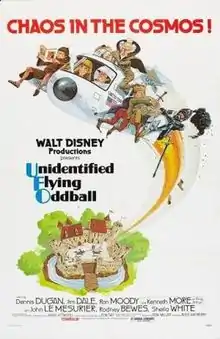Unidentified Flying Oddball
Unidentified Flying Oddball (UK title: The Spaceman and King Arthur) is a 1979 film adaptation of Mark Twain's 1889 novel A Connecticut Yankee in King Arthur's Court, directed by Russ Mayberry and produced by Walt Disney Productions. Subsequently re-released in the United States under the title A Spaceman in King Arthur’s Court, the film stars Dennis Dugan as NASA employee Tom Trimble who unintentionally travels back in time with his look-alike android Hermes.
| Unidentified Flying Oddball | |
|---|---|
 Theatrical release poster | |
| Directed by | Russ Mayberry |
| Produced by | Ron Miller |
| Written by | Don Tait |
| Based on | A Connecticut Yankee in King Arthur's Court novel by Mark Twain |
| Starring | Dennis Dugan Jim Dale Ron Moody Kenneth More John Le Mesurier |
| Music by | Ron Goodwin |
| Cinematography | Paul Beeson |
| Edited by | Peter Boita |
Production company | |
| Distributed by | Buena Vista Distribution |
Release date | July 19, 1979 (London)[1] August 3, 1979 (Los Angeles)[1] |
Running time | 93 minutes |
| Country | United Kingdom United States[1] |
| Language | English |
| Budget | $5.25 million[2] |
Premise
After Trimble’s NASA spacecraft travels faster than the speed of light, it takes him and his android back to King Arthur’s Camelot. They then use their 20th-century technology to help defeat a plot by the evil Sir Mordred and Merlin to oust King Arthur from his throne.[3][4]
Cast
- Dennis Dugan as Tom Trimble/Hermes
- Jim Dale as Sir Mordred
- Ron Moody as Merlin
- Kenneth More as King Arthur
- John Le Mesurier as Sir Gawain
- Rodney Bewes as Clarence
- Sheila White as Alisande ("Sandy")
- Robert Beatty as Senator Milburn
- Cyril Shaps as Dr. Zimmerman
- Kevin Brennan as Winston
- Ewen Solon as Watkins
- Pat Roach as Oaf
- Reg Lye as Prisoner
Production
The film was shot on location and at Pinewood Studios London.[2] Shooting locations included Alnwick Castle in Northumberland.[2]
The spacecraft featured in this movie was on display at the Blackgang Chine theme park in the Isle of Wight.
Reception
Variety wrote, "Pic has some good slapstick touches and offers a generous serving of visual tricks and space hardware, though on a par with Star Wars in that department it ain't."[5] Linda Gross of the Los Angeles Times stated, "The film will provide mildly amusing summer fun for those having their first encounter with castles and kings. However, A Connecticut Yankee in King Arthur's Court, Knights of the Round Table and Camelot all captured the vigor of medieval England with more passion."[6] Carla Hall of The Washington Post wrote: "The plot—obviously derived from 'A Connecticut Yankee in King Arthur's Court'—has the customary quantum of Disney cuteness as the story unravels predictably. But it takes advantage of the situation for some funny lines."[7] Martyn Auty of The Monthly Film Bulletin stated: "Quintessentially Arthurian locations and resplendent colour quality (that owes more to the processing lab than to Northumberland) put this updated version of Mark Twain's A Connecticut Yankee in King Arthur's Court a cut above its predecessors in the current Disney craze for space-visitor yarns."[8]
Remake
Disney’s A Kid in King Arthur’s Court (1995), likewise based on the aforementioned novel, follows the same premise: a contemporary American male (in this case, an adolescent) travels back in time to the 6th century and King Arthur’s Camelot, impressing the inhabitants with technology from the distant future. Moody again plays Merlin in the film, on this occasion as a more sympathetic character.
References
- "Unidentified Flying Oddball - Details". AFI Catalog of Feature Films. American Film Institute. Retrieved July 31, 2019.
- "Unidentified Flying Oddball - History". AFI Catalog of Feature Films. American Film Institute. Retrieved July 31, 2019.
- Mayberry, Russ (2004-08-03), The Unidentified Flying Oddball, Walt Disney Studios Home Entertainment, retrieved 2016-08-27
- "Unidentified Flying Oddball". Rotten Tomatoes. Retrieved July 31, 2019.
- "Film Reviews: Unidentified Flying Oddball". Variety. July 18, 1979. 16.
- Gross, Linda (August 3, 1979). "'Flying Oddball' in Days of Yore". Los Angeles Times. Part IV, p. 16.
- Hall, Carla (August 11, 1979). "Tracking the 'Oddball'". The Washington Post. B4.
- Auty, Martyn (July 1979). "The Spaceman and King Arthur". The Monthly Film Bulletin. 46 (546): 154.